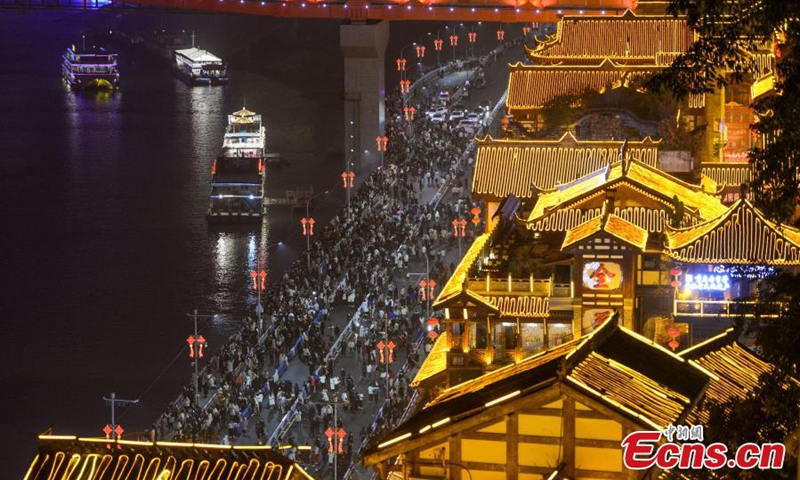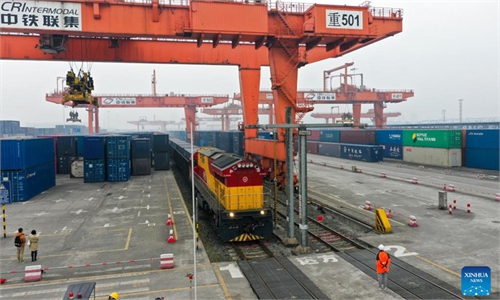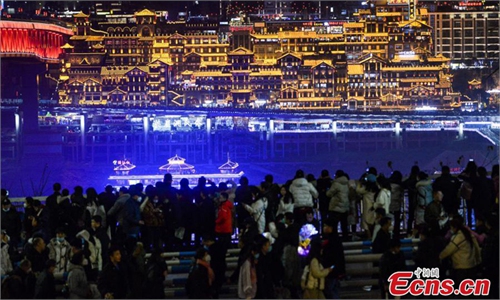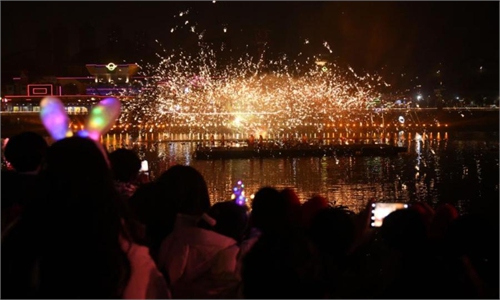LIFE / CULTURE BEAT
Chongqing brings history to life with archaeology-themed study tours

Tourists visit Hongya Cave in Chongqing at night, Jan. 26, 2023. (Photo: China News Service/He Penglei)
In Diaoyu city, an ancient fortress in Southwest China's Chongqing Municipality, a special tour was conducted recently with a focus on dilapidated walls, old stones and ordinary-looking locations, rather than the photogenic spots normally favored by tourists.In English, Diaoyu means fishing, and the site was named after the hill on which it was built in the latter part of the Southern Song Dynasty (1127-1279).
During the war between the Song imperial army and Mongolian troops in the 13th Century, Diaoyu city, as an important part of the defense system of the present-day Sichuan Province and Chongqing, withstood outside aggression for 36 years, a miraculous feat.
Ten people from four families were invited to the new archaeology-themed study tour, which was organized by Chongqing's institute of cultural relics and archaeology.
According to Yuan Dongshan, deputy head of the institute, the tour was designed to "make the cultural relics generate more vitality and cultivate the interest of participants in studying history and archaeology."
Yuan also served as a guide on the special tour, explaining the ruins of the Fanjiayan Song Dynasty government office to tourists. In 2018, the ruins within Diaoyu city were listed among China's top 10 archaeological discoveries.
"One of the reasons for Diaoyu city being granted this honor is that we excavated the earliest remains of a bomb found in China, and even in the world," Yuan said.
During the tour, Yuan also explained how the city wall was found inside a lush forest on the steep mountainside, how its history was pieced together from a stone tablet buried in moss, and how two tiny brass chess pieces were found at the bottom of a big pond.
"Archaeology is like embroidery because they both need subtlety and patience. Any stone, shard, even one sentence in the book, could be the crucial element for us to tie together the history," he said.
After the explanation, a 12-year-old boy named Liang Ruiqian asked about the most precious thing excavated by Yuan, who started Diaoyu city's archeological excavation 20 years ago.
"In fact, the whole structure and layout of Diaoyu city is the most valuable thing, instead of some single artifact," answered Yuan. "We often attach importance to movable cultural relics, while the immovable ones are of the same importance."
Yuan said it is amazing that ancient people built such a fully functional military base without modern technology. Their sense of space still intrigues archaeologists.
Official data show that Chongqing has about 26,000 immovable cultural relics and over 1.48 million movable ones. By the end of 2021, there were 108 million pieces (sets) of state-owned movable cultural relics, and about 767,000 immovable ones. The total number of world heritage sites in China has reached 56, ranking second in the world.
Other than the study tour, Chongqing has made other efforts to promote the charm of history and culture, such as opening the country's first archaeology-themed cafe and launching an immersive experience in a historic structure.
Xinhua



